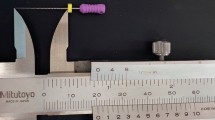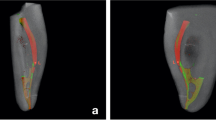Abstract
Objectives
The purpose of this study was to develop a customized framework for evaluating the registration accuracy of four registration techniques and measuring the untouched surface area of canal instrumentation by visually inspecting and calculating the overlapping area of the surfaces.
Methods
Twenty-one mandibular incisors were scanned by micro-computed tomography before and after instrumentation. Elastix registration, surface registration, manual registration, and DataViewer registration techniques were used to align the pre- and post-operative datasets. The customized MeVisLab framework was created to investigate the registration accuracy by visual inspection and calculating overlapping areas. The canal surfaces were imported into the same framework to measure the untouched surface area and the consistence test was validated. The correlation between registration accuracy and untouched surface area was analyzed.
Results
There is a statistically significant difference between manual registration and automatic registration (P < 0.05). There is no statistical difference between the two untouched surface measure methods (P > 0.05). The partial correlation coefficients for the untouched surface area and registration accuracy were 0.45 (P < 0.05).
Conclusions
This application framework based on free customizable software, allows a new method to measure registration accuracy and untouched surface area in an efficient and sensitive way. The application of a precise registration method would improve the quality of micro-CT canal instrumentation studies.
Clinical relevance
This study developed a customized framework based on free software for evaluating the registration accuracy of different registration techniques and measuring the untouched surface area of canal instrumentation could help researchers to improve the quality of micro-CT studies of canal instrumentation.



Similar content being viewed by others
References
Küçükyilmaz E, Savas S, Saygili G, Uysal B (2015) Assessment of apically extruded debris and irrigant produced by different nickel-titanium instrument systems. Braz Oral Res 29:1–6. https://doi.org/10.1590/1807-3107bor-2015.vol29.0002
Siqueira Junior JF, Rôças IDN, Marceliano-Alves MF, Pérez AR, Ricucci D (2018) Unprepared root canal surface areas: causes, clinical implications, and therapeutic strategies. Braz Oral Res 18(32):e65. https://doi.org/10.1590/1807-3107bor-2018.vol32.0065
Siqueira JF Jr, Pérez AR, Marceliano-Alves MF, Provenzano JC, Silva SG, Pires FR, Vieira GCS, Rôças IN, Alves FRF (2018) What happens to unprepared root canal walls: a correlative analysis using micro-computed tomography and histology/scanning electron microscopy. Int Endod J 51:501–508. https://doi.org/10.1111/iej.12753
Lopes RMV, Marins FC, Belladonna FG, Souza EM, De-Deus G, Lopes RT, Silva EJNL (2018) Untouched canal areas and debris accumulation after root canal preparation with rotary and adaptive systems. Aust Endod J 44:260–266. https://doi.org/10.1111/aej.12237
Shah S, Sundaram G, Bartlett D, Sherriff M (2004) The use of a 3D laser scanner using superimpositional software to assess the accuracy of impression techniques. J Dent 32:653–658. https://doi.org/10.1016/j.jdent.2004.07.005
Koerich L, Burns D, Weissheimer A, Claus JD (2016) Three-dimensional maxillary and mandibular regional superimposition using cone beam computed tomography: a validation study. Int J Oral Maxillofac Surg 45:662–669. https://doi.org/10.1016/j.ijom.2015.12.006
Cerqueira NM, Louzada VG, Silva-Sousa YTC, Raucci-Neto W, Leoni GB (2021) Effect of canal preparation with XP-endo Shaper and ProTaper Next on root canal geometry and dentin thickness of mandibular premolars with radicul-ar grooves and two canals: a micro-CT study. Clin Oral Investig 25:5505–5512. https://doi.org/10.1007/s00784-021-03858-z
Zhang Y, Liu J, Gu Y, Wang J, Xu H, Zhang G (2021) Analysis of second mesiobuccal root canal instrumentation in maxillary first molars with three nickel-titanium rotary instruments: a micro-computed tomographic study. Odontology 109:496–505. https://doi.org/10.1007/s10266-020-00564-2
Azim AA, Piasecki L, da Silva Neto UX, Cruz ATG, Azim KA (2017) XP Shaper, a novel adaptive core rotary instrument: micro-computed tomogr-aphic analysis of its shaping abilities. J Endod 43:1532–1538. https://doi.org/10.1016/j.joen.2017.04.022
Lin X, Chen T, Liu J, Jiang T, Yu D, Shen SG (2015) Point-based superi-mposition of a digital dental model on to a three-dimensional computed tomog-raphic skull: an accuracy study in vitro. Br J Oral Maxillofac Surg 53:28–33. https://doi.org/10.1016/j.bjoms.2014.09.007
Fernandes POF, Freire LG, Iglecias EF, Vieira BR, Zuolo ML, Gavini G (2020) Assessment of mechanical root canal preparation with centric reciprocating or eccentric rotary kinematics: a micro-computed tomographic study. J Endod 46:1309–1316. https://doi.org/10.1016/j.joen.2020.06.005
Sun L, Hwang HS, Lee KM (2017) Registration area and accuracy when integrating laser-scanned and maxillofacial cone-beam computed tomography images. Am J Orthod Dentofacial Orthop 153:355–361. https://doi.org/10.1016/j.ajodo.2017.06.027
Pan Y, Wang X, Dai F, Chen G, Xu T (2020) Accuracy and reliability of maxillary digital model (MDM) superimposition in evaluating teeth movement in adults compared with CBCT maxillary superimposition. Sci Rep 9(10):19384. https://doi.org/10.1038/s41598-020-76537-w
Ghoneima A, Cho H, Farouk K, Kula K (2017) Accuracy and reliability of landmark-based, surface-based and voxel-based 3D cone-beam computed tomography superimposition methods. Orthod Craniofac Res 20:227–236. https://doi.org/10.1111/ocr.12205
Haas Junior OL, Guijarro-Martínez R, Sousa Gil AP, Méndez-Manjón I, Valls-Otañón A, de Oliveira RB, Hernández-Alfaro F (2019) Cranial base superimposition of cone-beam computed tomography images: a voxel-based protocol validation. J Craniofac Surg 30:1809–1814. https://doi.org/10.1097/SCS.0000000000005503
Mukhia N, Birur NP, Shubhasini AR, Shubha G, Keerthi G (2021) Dimensional measurement accuracy of 3-dimensional models from cone beam computed tomography using different voxel sizes. Oral Surg Oral Med Oral Pathol Oral Radiol 132:361–369. https://doi.org/10.1016/j.oooo.2021.05.009
Jayaratne YS, McGrath CP, Zwahlen RA (2012) How accurate are the fusion of cone-beam CT and 3-D stereophotographic images? PLoS One 7:e49585. https://doi.org/10.1371/journal.pone.0049585
Nada RM, Maal TJ, Breuning KH, Bergé SJ, Mostafa YA, Kuijpers-Jagtman AM (2011) Accuracy and reproducibility of voxel based superimposition of cone beam computed tomography models on the anterior cranial base and the zygomatic arches. PLoS One 9(6):e16520. https://doi.org/10.1371/journal.pone.0016520
Almukhtar A, Ju X, Khambay B, McDonald J, Ayoub A (2014) Comparison of the accuracy of voxel based registration and surface based registration for 3D assessment of surgical change following orthognathic surgery. PLoS One 2(9):e93402. https://doi.org/10.1371/journal.pone.0093402
Peters OA, Arias A, Paqué F (2015) A micro-computed tomographic assessment of root canal preparation with a novel instrument, TRUShape, in mesial roots of mandibular molars. J Endod 41:1545–1550. https://doi.org/10.1016/j.joen.2015.06.007
Gao Y, Peters OA, Wu H, Zhou X (2009) An application framework of three-dimensional reconstruction and measurement for endodontic research. J Endod 35:269–274. https://doi.org/10.1016/j.joen.2008.11.011
Klein S, Staring M, Murphy K, Viergever MA, Pluim JP (2010) elastix: a toolbox for intensity-based medical image registration. IEEE Trans Med Imaging 29:196–205. https://doi.org/10.1109/TMI.2009.2035616
Bruker microCT (2017) MicroCT 3D registration after tooth root canal procedures: removed volume, drill debris and touched/untouched surfaces. Method note2017;MCT-101
Carter CS, Heckers S, Nichols T, Pine DS, Strother S (2008) Optimizing the design and analysis of clinical functional magnetic resonance imaging research studies. Biol Psychiatry 15(64):842–849. https://doi.org/10.1016/j.biopsych.2008.06.014
Huang J, Hu J, Luo R, Xie S, Wang Z, Ye Y (2019) Linear measurement-s of sinus floor elevation based on voxel-based superimposition of cone beam computed tomography images. Clin Implant Dent Relat Res 21:1048–1053. https://doi.org/10.1111/cid.12830
Molteni R (2013) Prospects and challenges of rendering tissue density in Hounsfield units for cone beam computed tomography. Oral Surg Oral Med Oral Pathol Oral Radiol 116:105–119. https://doi.org/10.1016/j.oooo.2013.04.013
Acknowledgements
This study was supported by the Funding of the Key Research and Development Program of Sichuan province (No. 2021YFS0031) and the National Natural Science Foundation of China (No. 62171193). The remaining authors deny any conflict of interest.
Funding
This study was supported by the Funding of the Key Research and Development Program of Sichuan province (No.2021YFS0031) and the National Natural Science Foundation of China (No.62171193).
Author information
Authors and Affiliations
Corresponding authors
Ethics declarations
Ethics approval
The protocol used in the present study was approved by the Medical Ethics Committee of West China Stomatological Hospital, Sichuan University (WCHSIRB-D-2020–388).
Informed consent
Not applicable.
Conflict of interest
The authors declare no competing interests.
Additional information
Publisher's note
Springer Nature remains neutral with regard to jurisdictional claims in published maps and institutional affiliations.
Rights and permissions
Springer Nature or its licensor (e.g. a society or other partner) holds exclusive rights to this article under a publishing agreement with the author(s) or other rightsholder(s); author self-archiving of the accepted manuscript version of this article is solely governed by the terms of such publishing agreement and applicable law.
About this article
Cite this article
Lui, K., Liu, H., Wang, H. et al. An application framework of 3D assessment image registration accuracy and untouched surface area in canal instrumentation laboratory research with micro-computed tomography. Clin Oral Invest 27, 715–725 (2023). https://doi.org/10.1007/s00784-022-04819-w
Received:
Accepted:
Published:
Issue Date:
DOI: https://doi.org/10.1007/s00784-022-04819-w




